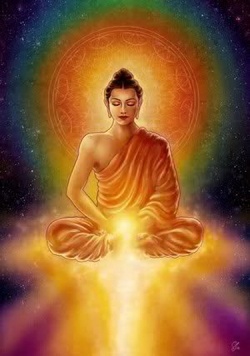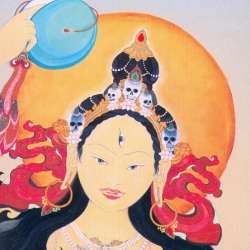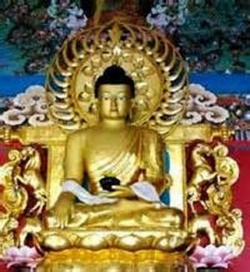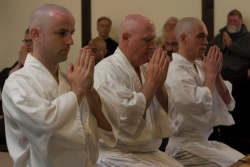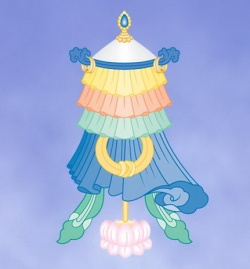What is real Bodhicitta
Apart from the view of 2-fold emptiness that dissolves grasping to self and dharma.
Vajrayana also holds that there is also the view of 'primordially pure appearance' that dissolves grasping to impure vision.
That is why in the final conclusion stages of Dzogchen, there is Togal which reveals in a natural way the visions of the mandalas and Buddhafields of the Buddha deities and so forth as a manifestation of rigpa.
For the Mahayana path, after the 8th Bhumi onwards, the Bodhisattva would gradually undo the grasping to impure appearances naturally, thus both the Mahayana and Vajrayana paths have the same Buddhahood result. However, in terms of expediency, the Vajrayana path tackles the grasping to impure appearances directly right from the beginning of the path, and thus is a much more swifter method towards defeating both kinds of grasping (grasping to self/dharma and grasping to impure phenomenon)
One teacher called Achuk Lama Rinpoche. He has attained the rainbow body and is famous for his display of Buddhas and other sacred signs on his own body which many thousands upon thousands have seen, including my friends. He uses these pure phenomenon as a skilful means to lead one to realise one's own true nature and also for ascertaining one's stage on the path etc. For him all phenomenon is pure and he sometimes does things like pick up ordinary pebbles from places to keep because he has pure view of those pebbles as deities mandalas etc.
When a Buddha attains Buddhahood, from the POV of the Vajrayana vehicle, all appearances to him are on the level of ultimate truth inseparable from the relative truth (this is the viewpoint of Vajrayana) and also, all impure appearances manifest as primoridally pure Buddhafields and deities.
I want to bring this up because many people do not yet understand the difference in viewpoints of the Vajrayana and Mahayana schools. It is important to be clearer about it esp for Vajrayana practitioner. If possible, i will try to take out the main points and compile another article about this in future when time permits.
The Unwritten Tantra (Yi ge med pa describes how the general original basis exists:
“There is no object to investigate within the view of self-originated wisdom: nothing went before, nothing happens later, nothing is present now at all. Action does not exist. Traces do not exist. Ignorance does not exist. Mind does not exist. Discriminating wisdom does not exist. Samsara does not exist. Nirvana does not exist. Even vidyā itself does not exist i.e. nothing at all appears in wisdom. That arose from not grasping anything.”
This is the state of original purity, The Blazing Lamp says:
Within initial original purity
the nature is like so:
not made by anyone, manifesting naturally,
the nature is already just so.
In this state, The Rosary of Pearls states:
The mere term delusion cannot be described
within the original purity of the initial state,
likewise, how can there be non-delusion?
Therefore, pure of delusion from the beginning.
The Heart Mirror states “All phenomena of the basis must be understood as the trio of essence, nature and compassion. All phenomena of the essence must be understood as emptiness. All phenomena of the nature must be understood as luminosity. All phenomena of compassion must be understood as pervading all sentient beings.”
So, of course, there must be essence, nature and compassion, timelessly present as the basis. Without these wisdoms, there can be no nirvana and no samsara. We can term these three "sugatagarbha" if we like. Padmasambhava states in the Clear Mirror:
Those three wisdoms pervade Samantabhadra and sentient beings down to the tiniest creature without any discrimination of good or bad, high or low.
Since these three wisdoms are themselves not established in anyway at all, we can be sure we are free from eternalism. Since these three natures always appear, we are free from annihilationism.
Vidya arises simultaneously with 8 vijnana. A moment of nonapprehension: sentient being. A moment of apprehension: Samantabhadra. No two moments, even though deluded discriminating mind sees two moments and re-liberation.
In the system of the Dzogchen Nyinghig three causes of ignorance are described -- those three are essence, nature and compassion. This is why there are three ignorances in this system. The system of explanation of Gongpa Zangthal is a little different, with only two ignorances -- we will continue with the Dzogchen Nyinthig system.
According to Garab Dorje, prior to the arising of the basis which is latent during the dark eon interval, nevertheless there are traces of affliction and action remaining from the previous eon. Because of these traces, the basis is stirred, the five lights appear and so on (this is why the Dzogcgen doctrine of two different kinds of Buddhahood is critical -- the first, the buddhahood that reverts the basis is the buddhahood asserted by all lower vehicles. The buddhahood that does not revert to the basis is the preserve of only Dzogchen).
The Gongpa Zangthal cycle supplies that during the arising of basis there is a neutral awareness (shes pa lung ma bstan) in the basis that does not recognize itself. This non-recognition is the innate ignorance. When this neutral awareness cognizes the five lights there is a dividing line between nirvana and samsara. When a neutral awareness recognizes the appearance of the basis as its own appearances it is is prajñā and is immediately liberated. That is Samantabhadra. A neutral awareness that does not recognize appearances as its own appearances immediately is the imputing ignorance, and samsara begins (again) because subject and object is imputed. This is all very clearly explained in detail in the eleven topics of Dzogchen Nyinthig. This is also clearly explained by Khenpo Ngawang Palzang.
Key point: innate enlightenment arises simultaneously with innate ignorance.
After the basis arises, innate ignorance is first and even Samantabhadra has it. There is period where a neutral awareness does not recognize itself in anyway. That is the innate ignorance. It (the neutral awareness) can only recognize itself through the display of five lights. When it recognizes that display as its own display, then this is the liberation of Samantabhadra without the performance of an iota of virtue. We on the other hand did not recognize these five lights as our own display, and for us, samsara began, without even an particle of non-virtue having been done.
According to Dzogchen teachings, all sentient being attain Buddhahood by the end of the eon -- this is very clearly stated by Garab Dorje in the commentary above. But there are two kinds of Buddhahood, and as I said above, there is only Buddhahood that does not revert to the basis, and that is the Buddhahood attained through Dzogchen methods. The Buddhahood of other vehicles reverts to the basis, without the corresponding result.
Now then, the reason why we cannot take these metaphors in Uttaratantra literally is that the basis is not Buddhahood. If the basis were Buddhahood, there would be no need for any kind of recognition.
In Dzogchen, there is a difference between the basis and the result. The difference is simply vidyā and avidyā and the recognition and non-recognition that comes from those.
Further, it is not enough merely to understand the general original basis. One must also understand the human body as a basis.
